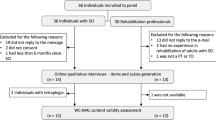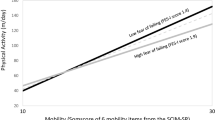Abstract
Study design:
Cross-sectional.
Objectives:
To describe the manual wheelchair (MWC) skill profiles of experienced MWC users with spinal cord injury and their wheeled mobility (distance and speed) while considering their level of injury and age.
Setting:
Rehabilitation centers, participant's home and the community.
Methods:
MWC skills were evaluated using the wheelchair skills test (WST) and wheeled mobility data were collected in the participants' own environment over a 7-day period, using a Cateye cycle computer (VELO 8). A total of 54 participants took part in the study.
Results:
The mean total performance score of the sample on the WST was 80.7±11.8%, with a significant difference between participants with tetraplegia (C4–C8) and those with low-level paraplegia (T7–L2) (P<0.01). The average daily distance covered was 2.5±2.1 km at 1.7±0.9 km h−1, with no significant difference between participants with paraplegia and those with tetraplegia (wheeled distance: P=0.70; speed: P=0.65). Significant relationships were found between MWC skills and daily wheeled distance (r=−0.32, P<0.05), but the correlation between these variables did not remain significant when controlling for age (partial r=0.26, P=0.07).
Conclusion:
These results suggest that the level of injury is related to MWC skills but not wheeled mobility. MWC skills are related to greater wheeled distance, but to a lesser extent when controlling for age.
Similar content being viewed by others
Log in or create a free account to read this content
Gain free access to this article, as well as selected content from this journal and more on nature.com
or
References
Noreau L, Fougeyrollas P . Long-term consequences of spinal cord injury on social participation: the occurrence of handicap situations. Disabil Rehabil 2000; 22: 170–180.
Fougeyrollas P, Bergeron H, Cloutier R, Côté J, St-Michel G . Classification québécoise: Processus de production du handicap. RIPPH: Lac St-Charles, 1998.
Kilkens OJ, Dallmeijer AJ, Nene AV, Post MW, van der Woude LH . The longitudinal relation between physical capacity and wheelchair skill performance during inpatient rehabilitation of people with spinal cord injury. Arch Phys Med Rehabil 2005; 86: 1575–1581.
Gagnon D, Verrier M, Masani K, Nadeau S, Aissaoui R, Popovic M . Effects of trunk impairments on wheelchair propulsion and wheelchair-related activities among individuals with spinal cord injury: a brief overview and future challenges. Top Spinal Cord Inj Rehabil 2009; 15: 59–70.
van der Woude LH, de Groot S, Janssen TW . Manual wheelchairs: research and innovation in rehabilitation, sports, daily life and health. Med Eng Phys 2006; 28: 905–915.
Lidal IB, Huynh TK, Biering-Sorensen F . Return to work following spinal cord injury: a review. Disabil Rehabil 2007; 29: 1341–1375.
van Velzen JM, de Groot S, Post MW, Slootman JH, van Bennekom CA, van der Woude LH . Return to work after spinal cord injury: is it related to wheelchair capacity at discharge from clinical rehabilitation? Am J Phys Med Rehabil 2009; 88: 47–56.
Wheelchair Skills Training Program (WSTP). Version 4.1. Wheelchair Skills Training Program (WSTP) Manual 2010. http://www.wheelchairskillsprogram.ca.
Kilkens OJ, Post MW, Dallmeijer AJ, van Asbeck FW, van der Woude LH . Relationship between manual wheelchair skill performance and participation of persons with spinal cord injuries 1 year after discharge from inpatient rehabilitation. J Rehabil Res Dev 2005; 42 (Suppl 1): 65–73.
Post MW, van Asbeck FW, van Dijk AJ, Schrijvers AJ . Services for spinal cord injured: availability and satisfaction. Spinal Cord 1997; 35: 109–115.
Jenkins S . Wheelchair Training Provision by NHS Wheelchair Services. Whizz-Kidz: London, 2002.
Karmarkar AM, Collins DM, Wichman T, Franklin A, Fitzgerald SG, Dicianno BE et al. Prosthesis and wheelchair use in veterans with lower-limb amputation. J Rehabil Res Dev 2009; 46: 567–576.
Best KL, Kirby RL, Smith C, MacLeod DA . Wheelchair skills training for community-based manual wheelchair users: a randomized controlled trial. Arch Phys Med Rehabil 2005; 86: 2316–2323.
Kirby RL, Mifflen NJ, Thibault DL, Smith C, Best KL, Thompson KJ et al. The manual wheelchair-handling skills of caregivers and the effect of training. Arch Phys Med Rehabil 2004; 85: 2011–2019.
Coolen AL, Kirby RL, Landry J, MacPhee AH, Dupuis D, Smith C et al. Wheelchair skills training program for clinicians: a randomized controlled trial with occupational therapy students. Arch Phys Med Rehabil 2004; 85: 1160–1167.
Lindquist N, Loudon P, Magis T, Rispin J, Kirby R, Manns P . Reliability of the performance and safety scores of the wheelchair skills test version 4.1 for manual wheelchair users. Arch Phys Med Rehabil 2010; 91: 1752–1757.
Fliess-Douer O, Vanlandewijck YC, Lubel Manor G, Van Der Woude LH . A systematic review of wheelchair skills tests for manual wheelchair users with a spinal cord injury: towards a standardized outcome measure. Clin Rehabil 2010; 24: 867–886.
Howarth SJ, Polgar JM, Dickerson CR, Callaghan JP . Trunk muscle activity during wheelchair ramp ascent and the influence of a geared wheel on the demands of postural control. Arch Phys Med Rehabil 2010; 91: 436–442.
Kilkens OJ, Dallmeijer AJ, Angenot E, Twisk JW, Post MW, van der Woude LH . Subject- and injury-related factors influencing the course of manual wheelchair skill performance during initial inpatient rehabilitation of persons with spinal cord injury. Arch Phys Med Rehabil 2005; 86: 2119–2125.
Wilson SK, Hasler JP, Dall PM, Granat MH . Objective assessment of mobility of the spinal cord injured in a free-living environment. Spinal Cord 2008; 46: 352–357.
Cooper RA, Tolerico M, Kaminski BA, Spaeth D, Ding D, Cooper R . Quantifying wheelchair activity of children: a pilot study. Am J Phys Med Rehabil 2008; 87: 977–983.
Price MJ . Thermoregulation during exercise in individuals with spinal cord injuries. Sports Med 2006; 36: 863–879.
Acknowledgements
This study was sponsored by Ontario Neurotrauma Foundation (ONF), the Quebec Rehabilitation Research Network (REPAR), the Centre de recherche en réadaptation et intégration sociale (CIRRIS), the Fondation pour la recherche sur la moelle épinière and the Social Sciences and Humanities Research Council (SSHRC) of Canada.
Author information
Authors and Affiliations
Corresponding author
Ethics declarations
Competing interests
The authors declare no conflict of interest.
Rights and permissions
About this article
Cite this article
Lemay, V., Routhier, F., Noreau, L. et al. Relationships between wheelchair skills, wheelchair mobility and level of injury in individuals with spinal cord injury. Spinal Cord 50, 37–41 (2012). https://doi.org/10.1038/sc.2011.98
Received:
Revised:
Accepted:
Published:
Issue date:
DOI: https://doi.org/10.1038/sc.2011.98
Keywords
This article is cited by
-
Goal attainment in mobility after acute rehabilitation of mobility-restricting paralysis syndromes with regard to the ambulatory therapeutic level of participation NeuroMoves
BMC Neurology (2021)
-
Leisure time physical activity among older adults with long-term spinal cord injury
Spinal Cord (2017)
-
Effects of rolling resistances on handrim kinetics during the performance of wheelies among manual wheelchair users with a spinal cord injury
Spinal Cord (2013)



